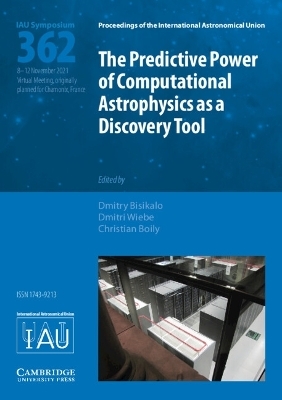
The Predictive Power of Computational Astrophysics as a Discovery Tool (IAU S362)
Cambridge University Press (Verlag)
978-1-108-49066-5 (ISBN)
A new paradigm for scientific discovery through computational tools now permeates every aspect of astronomical research. Computational astrophysics combines modern computational methods, novel hardware designs, advanced algorithms, original software implementations, and associated technologies to discover new phenomena and to make predictions in astronomy. The proceedings of IAU Symposium 362 summarizes ongoing developments in computational astrophysics through astronomers in diverse fields sharing their knowledge and approaches. It focuses on computational methods applied to speed up and broaden the scope of scientific studies, such as finding trends in observational data, high performance computing, automated search algorithms, and model predictability. Experts discuss a palette of challenging informational and technical developments, with the goal of coordinating their efforts and the improvement of techniques in pursuit of a wide range of astronomical studies, including fluid dynamics in star and galaxy evolution, exoplanets, gravitational waves, numerical relativity, data mining, and much more.
Early structure formation in the THESAN radiation-magneto-hydrodynamics simulations Enrico Garaldi; Simulations of dark matter with frequent self-interactions Moritz Fischer; Simulations of the reionization of the clumpy intergalactic medium with a novel particle-based two-moment radiative transfer scheme Tsang Keung Chan; Favoured inflationary models by SFC baryogenesis Mariana Panayotova; The effect of non-Gaussian primordial perturbations on large-scale structure Greco Peña; The complex evolution of supermassive black holes in cosmological simulations Peter Johansson; Nature of star formation in first galaxies Mahavir Sharma; The formation of Supersonically Induced Gas Objects (SIGOs) with H2 cooling Yurina Nakazato; An idealized setup for cosmological evolution of baryonic gas in isolated halos Shashank Dattathri; Detecting cosmic filamentary network with stochastic Bisous mode Moorits Mihkel Muru; Absorption spectra from galactic wind models: a framework to link PLUTO simulations to TRIDENT Benedetta Casavecchia; Hydrodynamic simulations and time-dependent photoionization modeling of starburst-driven superwinds Ashkbiz Danehkar; Numerical modelling of X-shaped radio galaxies using back-flow model Gourab Giri; Radiation magnetohydrodynamic simulations of soft x-ray emitting regions in active galactic nuclei Taichi Igarashi; Cold gas in outflow: Evidence for delayed positive AGN feedback Yu Qiu; A new code for relativistic hydrodynamics and its application to FR II radio jets Jeongbhin Seo; Studying magnetic field amplification in interacting galaxies using numerical simulations Simon Selg; X-ray spectral and image spatial models of NGC 3081 with Chandra data Iryna Vavilova; Simulating star formation in spiral galaxies Steven Rieder; The CNN classification of galaxies by their image morphological peculiarities Iryna Vavilova; Velocity-space substructures and bar resonances in an N-body Milky Way Tetsuro Asano; Fate of escaping orbits in barred galaxies Debasish Mondal; Dynamical evolution modeling of the Collinder 135 & UBC 7 binary star cluster Maryna Ishchenko; Multiparticle collision simulations of dense stellar systems and plasmas Pierfrancesco Di Cintio; A novel generative method for star clusters from hydrodynamical simulations Stefano Torniamenti; Stellar population photometric synthesis with AI of S-PLUS galaxies Vitor Cernic; Clustering stellar pairs to detect extended stellar structures Sergey Sapozhnikov; Kinetic modeling of auroral events at solar and extrasolar planets Valery Shematovich; Stellar activity effects on the atmospheric escape of hot Jupiters Hiroto Mitani; Study of the non-thermal atmospheric loss for exoplanet π Men c Anastasia Avtaeva; Multi-component MHD model for hydrogen-helium extended envelope of hot Jupiter Yuliya Gladysheva; Modeling stellar jitter for the detection of Earth-mass exoplanets via precision radial velocity measurements Samuel Granovsky; Thermal atmospheric escape of close-in exoplanets Eugenia Kalinicheva; Inference of magnetic fields and space weather hazards of rocky extrasolar planets from a dynamical geophysical model Varnana M. Kumar; Hydrodynamical simulations of misaligned accretion discs in binary systems: Companions tear discs Suzan Dogan; Hybrid magnetic structures around spinning black holes connected to a surrounding accretion disk Ileyk El Mellah; Mass ejection from neutron-star mergers Masaru Shibata; Merging of spinning binary black holes in globular clusters Margaryta Sobolenko; Predicting the expansion of supernova shells using deep learning toward highly resolved galaxy simulations Keiya Hirashima; Toward realistic models of core collapse supernovae: A brief review Anthony Mezzacappa; Hot spot drift in synchronous and asynchronous polars: synthesis of light curves Andrey Sobolev; The predictive power of numerical simulations in the study accretion an
| Erscheinungsdatum | 10.03.2023 |
|---|---|
| Reihe/Serie | Proceedings of the International Astronomical Union Symposia and Colloquia |
| Zusatzinfo | Worked examples or Exercises |
| Verlagsort | Cambridge |
| Sprache | englisch |
| Maße | 180 x 253 mm |
| Gewicht | 840 g |
| Themenwelt | Mathematik / Informatik ► Mathematik ► Computerprogramme / Computeralgebra |
| Naturwissenschaften ► Physik / Astronomie ► Astronomie / Astrophysik | |
| ISBN-10 | 1-108-49066-2 / 1108490662 |
| ISBN-13 | 978-1-108-49066-5 / 9781108490665 |
| Zustand | Neuware |
| Haben Sie eine Frage zum Produkt? |
aus dem Bereich


